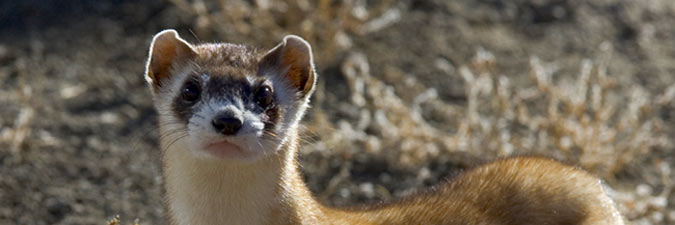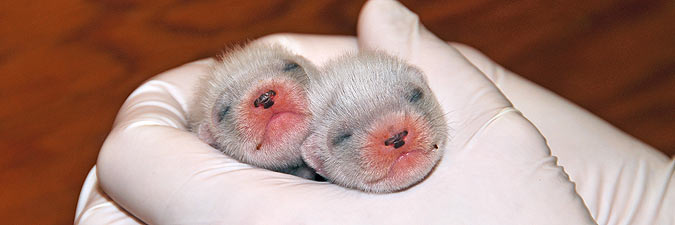When the Metro Toronto Zoo opened in 1974, it had been nearly forty years (1937) since the last wild black-footed ferrets had been seen in Canada. 1974 was also the year that the last known wild population in the United States died out—and the species was considered extinct in the wild. Native to prairie ecosystems, the ferrets are entirely dependent on prairie dogs for their survival. With European settlement of the prairies, farmers and ranchers deliberately poisoned prairie dog colonies and converted the land for agriculture, and unwittingly introduced sylvatic plague (a disease deadly to prairie dogs) to North America. As the prairie dog population dwindled, so too did the hope for the survival of the black-footed ferret.
Black-footed Ferret
Conservation Recovery Program

A chance encounter in 1981 (when a rancher’s dog in Meeteetse, Wyoming, brought home a dead ferret) thrust the species back into the conservation spotlight, proving that the species persisted. When an outbreak of canine distemper threatened the remaining ferrets in 1986, a last-ditch rescue effort was initiated. All of the remaining ferrets—18 individuals in total—were removed from the wild by 1987 to start a carefully managed breeding program. Working with the Wyoming Game and Fish Department and the U.S. Fish and Wildlife Service, the Zoo stepped up to become one of the few breeding centres for this endangered species in 1991. The goal: to produce enough offspring to return the black-footed ferret to the wild. On October 23, 1992, nine black-footed ferrets—or about 5% of the entire world population—arrived at the Zoo as the nucleus of a new breeding group.
For the past 32 years, the black-footed ferrets have been housed in one of the red barns across Meadowvale from the main Zoo. They are kept in strict isolation in order to protect them from disease and ensure that kits do not become habituated to humans before their reintroduction to the wild. The Toronto Zoo is proud to be one of only six facilities worldwide (and the only one in Canada) to breed this endangered species as part of the AZA Black-footed Ferret Species Survival Plan (as of 2022, known as the black-footed ferret SAFE program). The first ferret kits at the Zoo were born on June 16, 1993, and in September 1994, nine Toronto-born ferrets were sent to the United States Department of Interior to undergo “boot camp” in order to learn the skills necessary before being released to the wild.
Over thirty reintroduction sites have been activated within the United States, and in 2003 the Toronto Zoo spearheaded the effort to return the black-footed ferret to Canada. The black-footed ferret historically ranged in the Canadian Prairies (from southern Alberta to southern Saskatchewan). Grasslands National Park, Saskatchewan, was identified as the most promising site to return black-footed ferrets to: not only is it a protected area, but it contains the largest black-tailed prairie dog population in the country. In partnership with Parks Canada, U.S. Fish & Wildlife Service, the Calgary Zoo, private stakeholders, and other organizations, a joint Black-footed Ferret/Black-tailed Prairie Dog Recovery Team was established in 2004. And, following years of extensive research and planning, 34 ferrets were released onto Canadian soil on October 2, 2009—seventy years after the species was last seen in the wild.

With every reintroduction program, the release does not mark the end of the project. Post-release monitoring is crucial to evaluate the success of the individual releases, document methods that result in greater survival, and determine larger population trends. Is breeding observed? Is the population becoming self-sustaining? Does the wild population need to be supplemented with additional animals? Supported by the Canadian Wildlife Federation and the Toronto Zoo Endangered Species Reserve Fund, Toronto Zoo staff traveled to Grasslands National Park to participate in post-release monitoring sessions to monitor the 74 ferrets released between 2009 and 2012. Teams conducted nighttime surveys, using high-powered spotlights to detect the ferrets’ distinctive green eye-shine. This monitoring documented excellent winter survival rates, and in 2010 the first wild-born ferrets were observed in the park. Unfortunately, these successes were short-lived. Two severe droughts caused the prairie dog population to decline. And then disaster struck: sylvatic plague was detected in the park. In 2013, the decision was made to temporarily suspend the release of additional ferrets, and in 2015 monitoring efforts failed to document the presence of ferrets in the park. Recovery efforts are currently focused on conserving the prairie dog population, and there are no plans to reintroduce additional black-footed ferrets to Saskatchewan in the foreseeable future.
The short-lived success of the Canadian releases is disappointing, but the persistence of self-sustaining wild populations throughout the American prairies speaks to the success of the program overall. Breeding and reintroduction efforts continue to repopulate the ferret’s historical range and support wild populations that are not yet self-sustaining. Since 1993, 484 black-footed ferrets have been born and raised here at the Zoo, including 15 kits in 2024. While a few of these kits have remained in the breeding program, the vast majority have left zoo life, contributing to the reestablishment of this endangered native species in the wild.
How You Can Help Save Black-footed Ferrets
- Come out to the Zoo and find out more about the black-footed ferret and other endangered species the Toronto Zoo is working to save. Spread the word about what you have learned.
- Donate to conservation organizations.
You can find out more about volunteer opportunities assisting in monitoring wild black-footed ferrets in Grasslands National Park at the following link - www.pc.gc.ca/en/pn-np/sk/grasslands/activ/benevolat-volunteer












